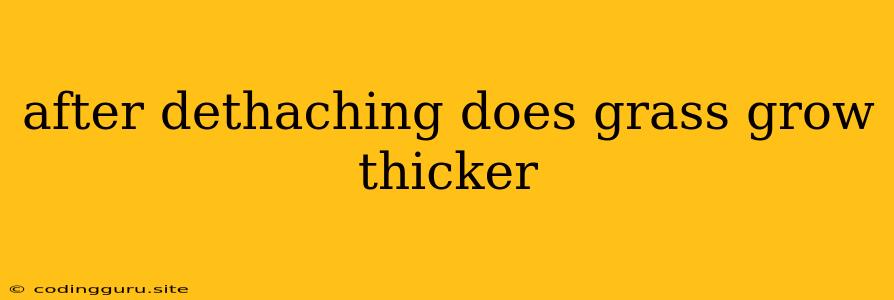Does Grass Grow Thicker After Dethatching?
Dethatching your lawn is a common practice for many homeowners, aimed at improving the health and appearance of their grass. However, a frequent question that arises is whether dethatching actually makes the grass grow thicker.
Understanding Thatch
Before we dive into the growth aspect, let's first define what thatch is. Thatch is a layer of dead grass, roots, and other organic matter that accumulates on your lawn. While a thin layer of thatch is beneficial, a thick layer can hinder healthy grass growth by:
- Blocking sunlight: Thick thatch prevents sunlight from reaching the soil, inhibiting photosynthesis in your grass.
- Restricting air flow: Reduced air circulation can lead to suffocating conditions for grass roots.
- Impairing water absorption: Thatch acts as a barrier, preventing water from penetrating the soil efficiently.
- Creating favorable conditions for pests and diseases: A thick thatch layer can provide a haven for insects and disease-causing organisms.
Does Dethatching Promote Thicker Growth?
Dethatching removes this accumulated layer, giving your grass a fresh start. While dethatching itself doesn't directly stimulate thicker growth, it creates a more conducive environment for healthy growth by:
- Allowing sunlight penetration: Removing the thatch layer allows more sunlight to reach the soil, increasing photosynthesis and promoting grass growth.
- Improving air circulation: Dethatching helps improve airflow, providing a healthy environment for your grass roots.
- Facilitating water absorption: With thatch removed, water can penetrate the soil more effectively, providing adequate hydration for your grass.
- Reducing pest and disease risks: Dethatching helps control pests and diseases by eliminating their hiding places.
The Role of Other Factors
It's important to remember that dethatching is just one step in the process of achieving a thicker lawn. Other factors play a significant role, including:
- Fertilization: Applying the right type and amount of fertilizer provides essential nutrients for healthy grass growth.
- Watering: Proper watering is crucial for maintaining healthy grass. Avoid overwatering or underwatering, as both can negatively impact growth.
- Mowing: Maintaining a proper mowing height and using sharp blades helps ensure healthy growth and prevents stress on your lawn.
- Soil aeration: Aeration helps improve drainage and allows oxygen to reach the roots.
Tips for Effective Dethatching
- Time it right: Dethatching is most effective in early spring or late fall when the grass is actively growing.
- Choose the right tool: There are several dethatching tools available, including power rakes and vertical mowers. Choose the one that best suits your lawn size and thatch thickness.
- Don't overdo it: Dethatching too often can damage your lawn. Only dethatch when necessary, typically every 3-5 years.
- Follow up with proper care: After dethatching, fertilize, water, and mow your lawn regularly to support healthy growth.
Conclusion
While dethatching doesn't directly make grass grow thicker, it creates an optimal environment for healthy growth by removing thatch and promoting sunlight penetration, air circulation, and water absorption. By combining dethatching with proper fertilization, watering, mowing, and aeration practices, you can significantly improve the health and thickness of your lawn. Remember, a healthy lawn is the foundation for a beautiful and thriving landscape.
